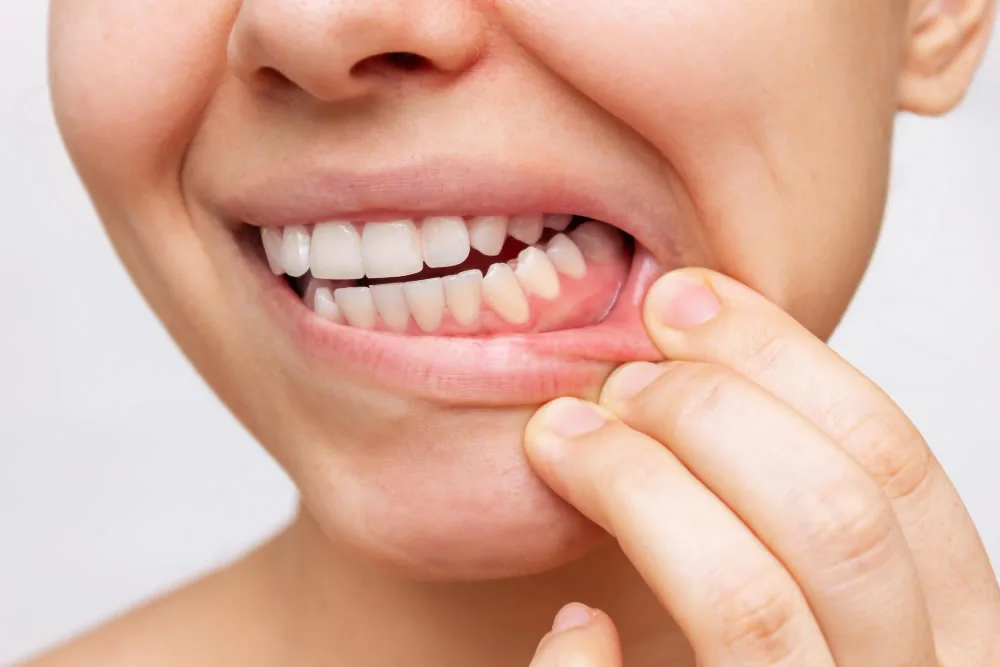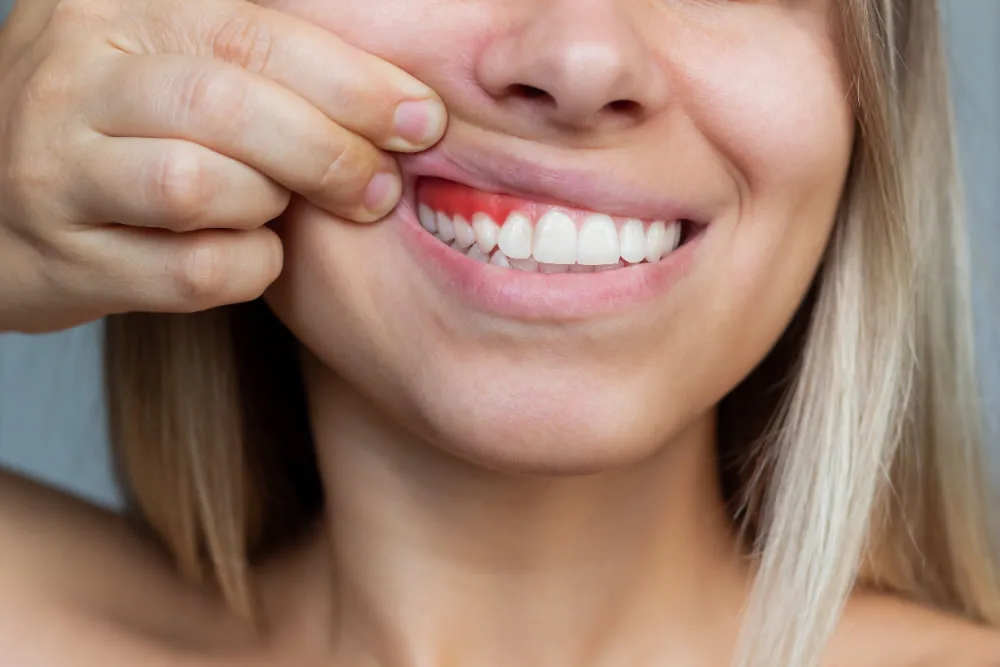
Receding gums refer to the condition where gum tissues pull back, exposing the tooth root. It is a highly common issue in society and should be treated early. Without treatment, tooth loss can occur solely due to receding gums. Additionally, the loss of supporting tissues for the teeth can lead to significant damage to the bone structures.
Gums, known as gingiva, are rich in blood vessels and thus appear pink. When various gum diseases occur, the gums may turn red and swell. It is essential not to confuse gum diseases with receding gums. Not all gum diseases lead to receding gums, but every gum disease requires treatment. Gum recession is a slow-progressing issue, making it challenging for patients to notice its onset. This highlights the importance of regular dental check-ups. During these routine check-ups, any early signs of gum recession can be easily detected by a dentist, allowing timely initiation of necessary treatments.
Although it is a slowly progressing condition, receding gums do exhibit certain symptoms. These symptoms may not always cause severe discomfort for patients, but even the presence of one symptom warrants an immediate dental consultation. We will discuss the symptoms of receding gums and provide answers to questions about how it is treated or when surgical intervention may be required.
What Are the Symptoms of Receding Gums?
In its early stages, receding gums may not present any symptoms. By the time patients experience complaints, gum recession has often become noticeable. The most common issue at this stage is sensitivity. When patients visit a dental clinic due to tooth or gum sensitivity, diagnosing the problem becomes possible. Generally, the symptoms of receding gums are as follows:
- Bleeding gums during brushing
- Teeth appearing longer than usual
- Redness in the gums
- Swelling in the gums
- Mild bleeding in the gums while eating hard foods
None of these situations should be considered normal. Even if only one or a few of these symptoms are present, it is crucial to visit a dental clinic promptly. Healthy gums do not exhibit the problems listed above.
Who is Affected by Receding Gums?
Receding gums can affect individuals of all ages. However, age is a significant factor. Studies show that approximately 88% of people over 65 experience receding gums. While commonly associated with older age, this condition is not exclusive to it. Younger individuals can also develop receding gums, especially those who use tobacco products, regardless of age. Family history is another crucial factor; individuals with a family history of receding gums are at higher risk. Additionally, diabetes can contribute to gum recession. For these groups, maintaining routine oral and dental check-ups is even more critical.
How is Receding Gums Treated?
Treatment for receding gums is not a one-size-fits-all approach. As previously mentioned, gum recession can occur due to various factors, and treatment methods vary accordingly. The extent of the receding gums is another critical determinant of the treatment procedure. If an infection is present, antibiotics are necessary to eliminate the problem.
For mild gum recession, cleaning dental calculus and removing plaque from the root surfaces can help slow the progression. This is essential because accumulated bacteria in the mouth can accelerate the issue. However, for advanced gum recession, success with non-surgical treatments is nearly impossible, making surgical intervention mandatory.
Patients with receding gums often experience sensitivity as a complaint. Treatments aimed at addressing this issue may include measures to prevent exposed tooth roots from causing sensitivity. The specific surgical methods employed during treatment vary depending on the individual’s condition, particularly the severity of the gum recession. Regardless of the treatment procedure, patients must prioritize oral and dental hygiene for successful outcomes.
Which Surgical Methods Are Used to Treat Receding Gums?
The surgical methods used to treat receding gums depend on the patient’s overall condition. Commonly, the following techniques are preferred:
Open Flap Surgery
During an open flap surgery, the gum tissue is folded back to remove harmful bacteria from the periodontal pocket. Once the bacteria are thoroughly cleaned, the gum tissue is repositioned to cover the tooth root. This procedure may also reduce the size of the gaps that form during the intervention.
Guided Tissue Regeneration
Guided tissue regeneration is employed when gum recession has significantly damaged the teeth and bone structure. This surgical procedure reduces pocket depth by applying materials such as membranes or graft tissues to the affected area. The gum tissue is then stabilized over the tooth root, completing the regeneration process.
Soft Tissue Graft
A soft tissue graft is one of the most commonly used methods, with connective tissue grafts being particularly popular. This procedure involves taking a piece of tissue from the upper palate and suturing it to the gums to cover the exposed tooth root. If suitable tissue from the upper palate is unavailable, the graft may be taken from another area.
How Common is Receding Gums?
Receding gums are much more prevalent than commonly assumed. This condition is especially widespread among individuals who neglect oral and dental hygiene and those over the age of 65. Tobacco users are also highly prone to gum recession. The issue can occur in just one or a few teeth or affect multiple areas of the mouth.
What Causes Receding Gums?

Receding gums cannot be attributed to a single factor, as various reasons may contribute to this condition. The most common causes include:
- Gum diseases, particularly bacterial gum infections, are the most frequent cause of gum recession.
- Incorrect or overly aggressive tooth brushing techniques can also lead to this problem.
- Neglecting oral and dental care may result in gum recession.
- Hormonal fluctuations in the body can also cause gum recession. These fluctuations often occur during menopause, puberty, or childbirth, making these times particularly susceptible to gum issues.
- Tobacco use is one of the primary causes of gum recession.
- Habits like grinding or clenching teeth can contribute to the condition.
- Misaligned or crooked teeth are also among the reasons for gum recession.
- Lip or tongue piercings that frequently contact the gums may lead to gum recession.
Can Gums Grow Back?
No, unfortunately, gums do not grow back or fill in the gaps once recession has occurred. In some cases, gum recession may stem from gum diseases that also cause swelling in the gums. Patients might mistakenly believe their gums are regenerating due to the swelling. However, once the swelling subsides, the gums return to their previous position. As a result, gum regrowth is not possible.
How Can I Reduce Sensitivity Caused by Receding Gums?
Patients with receding gums often experience sensitivity, which can lead them to neglect oral and dental care. However, neglecting oral hygiene is one of the worst mistakes. Patients should continue their oral care routine, using a toothbrush with soft bristles whenever possible. Additionally, toothpaste designed to reduce sensitivity can be helpful—consult your dentist for recommendations. Your dentist may also provide treatments specifically aimed at alleviating sensitivity.
What is the Best Toothpaste for Receding Gums?
It is best to consult your dentist about which toothpaste to use. Gum recession varies in severity for each patient, and after an examination, your dentist can recommend the most suitable toothpaste for your condition.
Check it out –> Antalya Dental Clinic
Can Receding Gums Be Prevented?
Yes, receding gums can be prevented, but patients must maintain consistent oral and dental hygiene. Regular dental check-ups are crucial as they help identify gum diseases and other issues early. Routine visits allow your dentist to detect and address gum recession promptly.
It might interest you –> Hollywood Smile Turkey
How Can Receding Gums Be Prevented?
The first step in preventing gum recession is brushing your teeth with the appropriate toothbrush and toothpaste, using the correct technique. Additionally, cleaning between your teeth and along the surfaces with dental floss is essential. A balanced and healthy diet is critical for overall body systems, including gum health. Maintaining and adhering to such a diet is highly recommended.
Avoid highly acidic foods and beverages, as well as tobacco products. These measures are crucial in preventing gum recession.
Feel free to write any questions about gum recession in the comments section.
For your information –> Composite Veneers
